813. Cape Weaver Ploceus capensis (Kaapse Wewer)
Order: Passeriformes. Family: Ploceidae
Description
Length 17-18 cm, weight: 36-55 g; males larger than females. The Cape Weaver is a stocky bird with streaked olive-brown upper parts and a long pointed conical bill.
Adult male breeding: Head yellow, face with variable chestnut-brown to orange-brown wash. Nape and remainder of upper parts olive green, mantle finely streaked dark olive-brown. Tail olive-brown, rectrices edged greenish yellow. Flight feathers, and greater and median coverts olive-brown, edged greenish yellow. Underwing pale yellowish. Underparts yellow, except for buffy to chestnut-brown or orange-brown chin. Some with breast and belly flecked chestnut-brown. Bill black. Eyes cream to white. Legs and feet brown.
Adlt male non-breeding: As breeding male, but upper parts duller olive green, underparts dull yellow; often lacks chestnut wash on head and throat. Bill brown. Some individual variation in extent of moult into eclipse plumage.
Adult female: Dull olive-brown above; crown and mantle with faint streaking. Tail olive-brown. Wings brown, coverts with narrow greenish-yellow edges. Chin and throat creamy, with yellowish wash. Breast and flanks buffy yellow; belly and vent yellowish, thighs washed olive. Bill brown. Eyes dark brown (rarely cream). Legs and feet brown. Adult females usually have brown eyes, but 19% have pale eyes in summer and thus eye colour alone cannot be used to sex this species.
Juvenile: As adult female, but upper parts more olive green; yellowish margins to wing coverts broader. Eyes of male dark brown, becoming grey-white after 5-8 month. Male only acquires full breeding plumage in second year. Young Cape Weavers have yellow bellies (young Southern Masked Weavers have whitish bellies).
Similar species: Spectacled Weaver smaller and more slightly built, with more slender bill, uniform (not pale-edged) wing coverts and distinctive black eye stripe. Female Village and Southern Masked- Weavers are smaller and usually more brightly coloured, with rather whitish bellies, often with red (not dark brown) eyes; bills shorter.
Distribution
Endemic to South Africa, Lesotho and Swaziland, occurring across much of the area excluding the Kalahari Desert.
Habitat
Open grassland, lowland fynbos, coastal thicket and farmland, provided they have permanent water and trees.
Diet
Omnivorous, as its diet it is pretty much equally split between arthropods and plant matter, especially seeds, fruit and nectar. It forages on the ground and in tree foliage, gleaning food from crevices in bark and hawking insects aerially.
Breeding
Polygynous, territorial colonial nester, as males may have up to 7 female in one breeding season, usually living together in colonies of about 2-20 males. Each builds multiple nests within a small territory, which it vigorously defends against intruders. Females test how a sturdy a nest is by pulling at material in the inside; if it is accepted the female adopts a hunched posture in readiness for mating. The nest is built solely by the male in about 7 days, consisting of a kidney-shaped, fully waterproof structure made of woven broad strips of grass or reeds, usually without an entrance tunnel. If the female accepts, she lines it with fine grass. The nest is typically attached to the tip of a tree branch, especially of a Eucalyptus or willow (Salix), or alternatively in a bank of reeds (Phragmites) or Bulrushes (Typha capensis), on telephone lines or in in fences overlooking water. Egg-laying season is from June-February, peaking from October-January in summer rainfall areas, earlier from August-October in the Western Cape. It lays 2-5 eggs, which are incubated solely by the female for about 13-14 days. The chicks are brooded by the female for the first few nights of their lives, after which she roosts in an adjacent unused nest. They are initially fed mainly by the female, but later the male takes a greater role in providing food; the young leave the nest at about 17 days old.
Call
A harsh azwit, azwit. Listen to Bird Call.
Status
Endemic. Common resident.
Africa Wild Bird Book
- Lisbeth
- Site Admin
- Posts: 67467
- Joined: Sat May 19, 2012 12:31 pm
- Country: Switzerland
- Location: Lugano
- Contact:
Cape Weaver
"Education is the most powerful weapon which you can use to change the world." Nelson Mandela
The desire for equality must never exceed the demands of knowledge
The desire for equality must never exceed the demands of knowledge
- Lisbeth
- Site Admin
- Posts: 67467
- Joined: Sat May 19, 2012 12:31 pm
- Country: Switzerland
- Location: Lugano
- Contact:
Cape Weaver Photos
813. Cape Weaver Ploceus capensis
 © Ronnie
© Ronnie
Male, Addo Elephant National Park
 © Ronnie
© Ronnie
Breeding male
 © Mel
© Mel
Non-breeding male
 © Flutterby
© Flutterby
Female
 © nan
© nan
Cape Weaver nests often hang from the dropping branches of Willow-trees. Materials used for the nest include fine leaf-fibbers, grasses and small twigs. Male starts by building a ring with woven grasses, and from this ring, it weaves the brood chamber, and after this first work, it leans backwards in order to prepare the ante-chamber. We can see a downward facing entrance. Nest is suspended from a branch or reed and it is relatively big.
The nest is a bulky, kidney-shaped structure, with the entrance below and usually without an entrance tunnel. Males display from their nests to attract females. If a female accepts a nest, she lines it with fine grass.
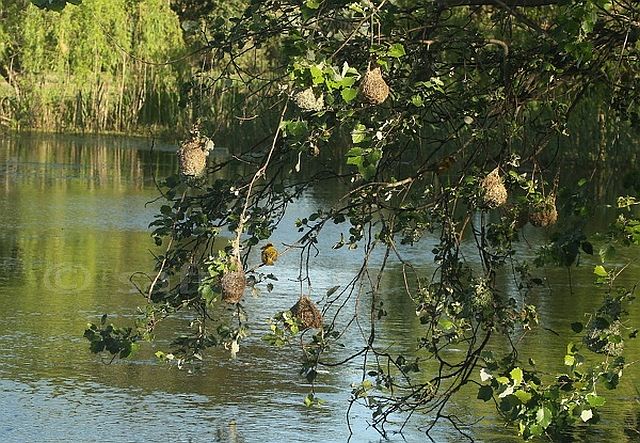 © nan
© nan
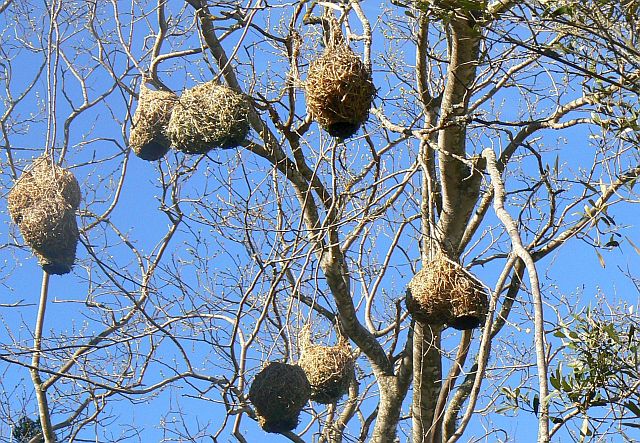 © Toko
© Toko
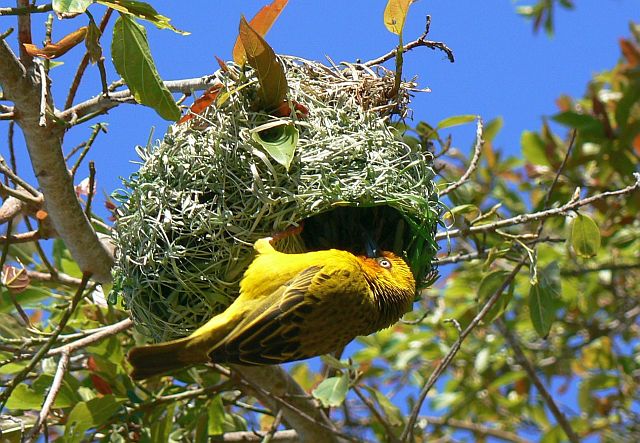 © Toko
© Toko
 © nan
© nan
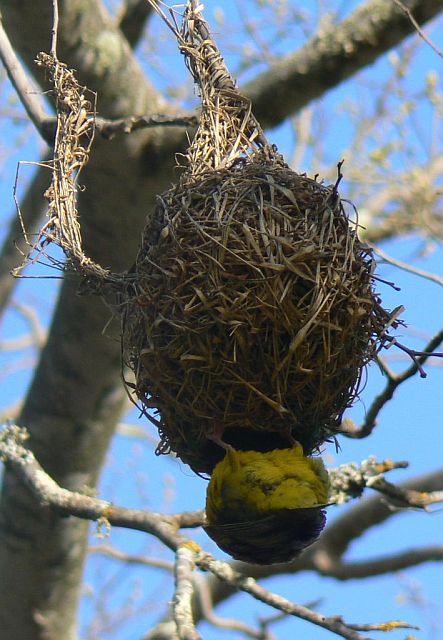 © Toko
© Toko
 © nan
© nan
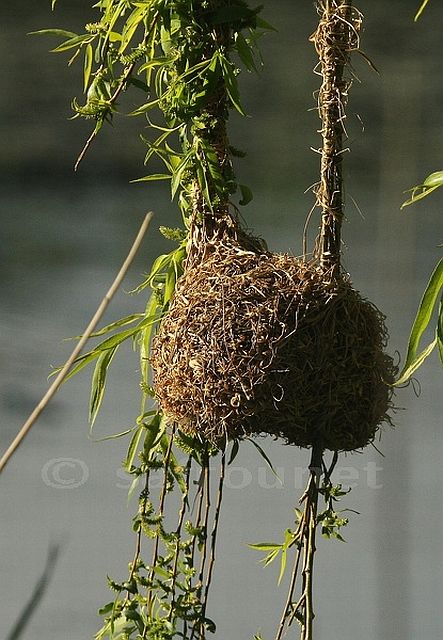 © nan
© nan
Links:
Species text in The Atlas of Southern African Birds: http://sabap2.adu.org.za/docs/sabap1/813.pdf
Sabap2: http://sabap2.adu.org.za/spp_summary.ph ... §ion=3
SANBI
Weaver Watch: http://weavers.adu.org.za/newstable.php?id=322
Ian Sinclair. SASOL VOELS VAN SUIDER AFRICA (3de UIT)
Weaver Wednesday: Cape Weaver
Iris colours in ageing and sexing South African Ploceus weavers. Afring News 40:7-12
Oiseaux net: http://www.oiseaux-birds.com/card-cape-weaver.html
 © Ronnie
© RonnieMale, Addo Elephant National Park
 © Ronnie
© RonnieBreeding male
 © Mel
© MelNon-breeding male
 © Flutterby
© FlutterbyFemale
 © nan
© nanCape Weaver nests often hang from the dropping branches of Willow-trees. Materials used for the nest include fine leaf-fibbers, grasses and small twigs. Male starts by building a ring with woven grasses, and from this ring, it weaves the brood chamber, and after this first work, it leans backwards in order to prepare the ante-chamber. We can see a downward facing entrance. Nest is suspended from a branch or reed and it is relatively big.
The nest is a bulky, kidney-shaped structure, with the entrance below and usually without an entrance tunnel. Males display from their nests to attract females. If a female accepts a nest, she lines it with fine grass.
 © nan
© nan © Toko
© Toko © Toko
© Toko © nan
© nan © Toko
© Toko © nan
© nan © nan
© nanLinks:
Species text in The Atlas of Southern African Birds: http://sabap2.adu.org.za/docs/sabap1/813.pdf
Sabap2: http://sabap2.adu.org.za/spp_summary.ph ... §ion=3
SANBI
Weaver Watch: http://weavers.adu.org.za/newstable.php?id=322
Ian Sinclair. SASOL VOELS VAN SUIDER AFRICA (3de UIT)
Weaver Wednesday: Cape Weaver
Iris colours in ageing and sexing South African Ploceus weavers. Afring News 40:7-12
Oiseaux net: http://www.oiseaux-birds.com/card-cape-weaver.html
"Education is the most powerful weapon which you can use to change the world." Nelson Mandela
The desire for equality must never exceed the demands of knowledge
The desire for equality must never exceed the demands of knowledge
- nan
- Posts: 26318
- Joined: Thu May 31, 2012 9:41 pm
- Country: Switzerland
- Location: Central Europe
- Contact:
Chestnut Weaver
812. Chestnut Weaver Ploceus rubiginosus (Bruinwewer)
Order: Passeriformes. Family: Ploceidae
Description
14cm; 30g
Breeding Male has a black head and dark chestnut back and underparts and a grey rump. The non-breeding male is similar to the drab female with greyish brown upperparts, a pale cream-yellow throat and a pale brown breast band. Juveniles are similar the the females, but the breast band is lightly streaked.
Distribution
Occurs in two separate areas of sub-Saharan Africa; one extending from Ethiopia to Tanzania and the other population restricted to south-western Angola and southern Africa. Here it is locally common in northern and central Namibia and north-western Botswana.
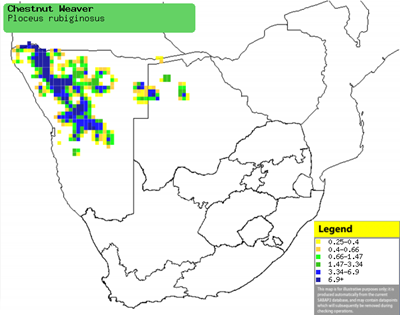
Habitat
Dry thornveld and riverine woodland.
Diet
Mainly seeds, but also insects and nectar.
Breeding
Polygynous and highly colonial, usually breeding in huge colonies of at least 200 nests in a single tree, but sometimes in over 100 adjacent trees each with 40-100 nests!
The nest is built solely by the male, consisting of a retort-shaped structure with a short entrance tunnel at the base. It is usually woven from grasses such as Common nine-awned grass (Enneapogonn cenchroides), love grasses (Eragrostis) and bushman grass (Stipagrostis), and if accepted by the female she lines it with grass seed heads. It is typically strung from the tip of a branch of a tree, such as Acacia, Albizia and Mopane (Colosphermum mopane), about 3-8 metres above ground. It breeds in response to rainfall with an egg-laying season from December-May, peaking from January-March. It lays 1-6 eggs, which are incubated solely by the female for about 11-14 days. The chicks are fed by the female only on a diet of mainly insects, such as caterpillars, grasshoppers and crickets (Orthoptera), leaving the nest after about 13-16 days.
Call
Usual "chuk, chuk" and swizzling weaver notes.
Status
Not threatened. Locally common; nomadic breeding migrant.
Order: Passeriformes. Family: Ploceidae
Description
14cm; 30g
Breeding Male has a black head and dark chestnut back and underparts and a grey rump. The non-breeding male is similar to the drab female with greyish brown upperparts, a pale cream-yellow throat and a pale brown breast band. Juveniles are similar the the females, but the breast band is lightly streaked.
Distribution
Occurs in two separate areas of sub-Saharan Africa; one extending from Ethiopia to Tanzania and the other population restricted to south-western Angola and southern Africa. Here it is locally common in northern and central Namibia and north-western Botswana.

Habitat
Dry thornveld and riverine woodland.
Diet
Mainly seeds, but also insects and nectar.
Breeding
Polygynous and highly colonial, usually breeding in huge colonies of at least 200 nests in a single tree, but sometimes in over 100 adjacent trees each with 40-100 nests!
The nest is built solely by the male, consisting of a retort-shaped structure with a short entrance tunnel at the base. It is usually woven from grasses such as Common nine-awned grass (Enneapogonn cenchroides), love grasses (Eragrostis) and bushman grass (Stipagrostis), and if accepted by the female she lines it with grass seed heads. It is typically strung from the tip of a branch of a tree, such as Acacia, Albizia and Mopane (Colosphermum mopane), about 3-8 metres above ground. It breeds in response to rainfall with an egg-laying season from December-May, peaking from January-March. It lays 1-6 eggs, which are incubated solely by the female for about 11-14 days. The chicks are fed by the female only on a diet of mainly insects, such as caterpillars, grasshoppers and crickets (Orthoptera), leaving the nest after about 13-16 days.
Call
Usual "chuk, chuk" and swizzling weaver notes.
Status
Not threatened. Locally common; nomadic breeding migrant.
Kgalagadi lover… for ever
https://safrounet.piwigo.com/
https://safrounet.piwigo.com/
- nan
- Posts: 26318
- Joined: Thu May 31, 2012 9:41 pm
- Country: Switzerland
- Location: Central Europe
- Contact:
Chestnut Weaver Photos
812. Chestnut Weaver Ploceus rubiginosus
 © nan
© nan
Etosha
Links:
http://www.biodiversityexplorer.org/bir ... inosus.htm
 © nan
© nanEtosha
Links:
http://www.biodiversityexplorer.org/bir ... inosus.htm
Kgalagadi lover… for ever
https://safrounet.piwigo.com/
https://safrounet.piwigo.com/
Eastern Golden Weaver, Yellow Weaver
817. Eastern Golden Weaver, Yellow Weaver Ploceus subaureus (Geelwewer)
Order: Passeriformes. Family: Ploceidae
Description
11-14 cm. Golden yellow weaver.
The male in breeding plumage has a black bill and red eye. Some have an orange wash to the face.
Female and non breeding male have greenish backs with streaking and are yellow below with a horn to dark bill, and eye is brown or reddish brown.
Juveniles resemble females.
Similar species: Smaller and brighter yellow than Holub's Golden Weaver, has a shorter smaller bill and red (not yellow) eyes. Male may be distinguished from the larger, pale-eyed Cape Weaver by its more vivid yellow plumage and more rounded head.
Distribution
Occurs from Kenya through Tanzania to Malawi and Mozambique, extending down the east coast to KwaZulu-Natal and the Eastern Cape.
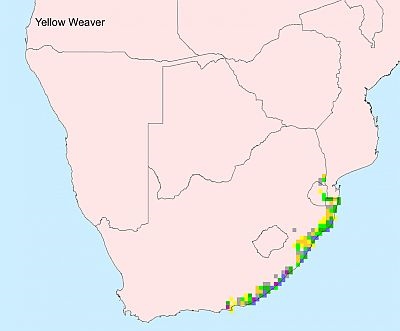
Habitat
It generally prefers river flood plains, coastal plains, estuaries and lowland river valleys, but it is mainly restricted to reedbeds and adjacent riverine vegetation.
Diet
It mainly eats seeds, insects and nectar, foraging on the ground and in vegetation, occasionally hawking termite alates aerially.
Breeding
Probably polygynous colonial nester, with about 10-20, rarely 50 nests per colony, sometimes breeding alongside Southern brown-throated (Ploceus xanthopterus) and Thick-billed weavers (Amblyospiza albifrons). Each male builds multiple circular nests which lack an entrance tunnel, woven from grass stems or reed strips and lined by the female with softer grass. It is typically attached to one, sometimes two reed stems about 1-2 m above water, although it may occasionally use trees instead. Egg-laying season is from about September-February, peaking from September-December. It lays 2-4 eggs, which are incubated solely by the female. The chicks are fed on a diet of mainly insects, leaving the nest after about 19-22 days.
Status
Locally common resident.
Order: Passeriformes. Family: Ploceidae
Description
11-14 cm. Golden yellow weaver.
The male in breeding plumage has a black bill and red eye. Some have an orange wash to the face.
Female and non breeding male have greenish backs with streaking and are yellow below with a horn to dark bill, and eye is brown or reddish brown.
Juveniles resemble females.
Similar species: Smaller and brighter yellow than Holub's Golden Weaver, has a shorter smaller bill and red (not yellow) eyes. Male may be distinguished from the larger, pale-eyed Cape Weaver by its more vivid yellow plumage and more rounded head.
Distribution
Occurs from Kenya through Tanzania to Malawi and Mozambique, extending down the east coast to KwaZulu-Natal and the Eastern Cape.

Habitat
It generally prefers river flood plains, coastal plains, estuaries and lowland river valleys, but it is mainly restricted to reedbeds and adjacent riverine vegetation.
Diet
It mainly eats seeds, insects and nectar, foraging on the ground and in vegetation, occasionally hawking termite alates aerially.
Breeding
Probably polygynous colonial nester, with about 10-20, rarely 50 nests per colony, sometimes breeding alongside Southern brown-throated (Ploceus xanthopterus) and Thick-billed weavers (Amblyospiza albifrons). Each male builds multiple circular nests which lack an entrance tunnel, woven from grass stems or reed strips and lined by the female with softer grass. It is typically attached to one, sometimes two reed stems about 1-2 m above water, although it may occasionally use trees instead. Egg-laying season is from about September-February, peaking from September-December. It lays 2-4 eggs, which are incubated solely by the female. The chicks are fed on a diet of mainly insects, leaving the nest after about 19-22 days.
Status
Locally common resident.
Eastern Golden Weaver Photos
817. Eastern Golden Weaver Ploceus subaureus
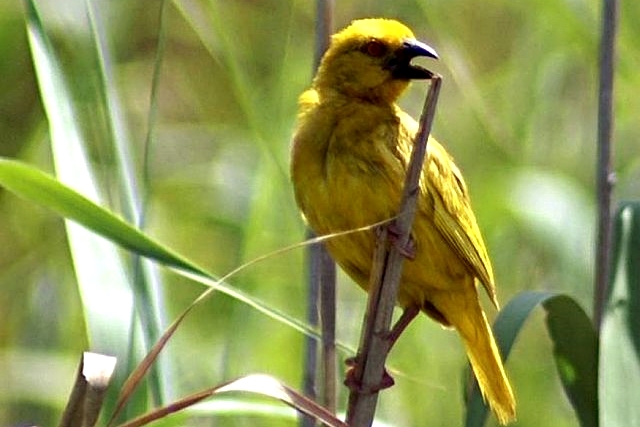 © Toko
© Toko
Male
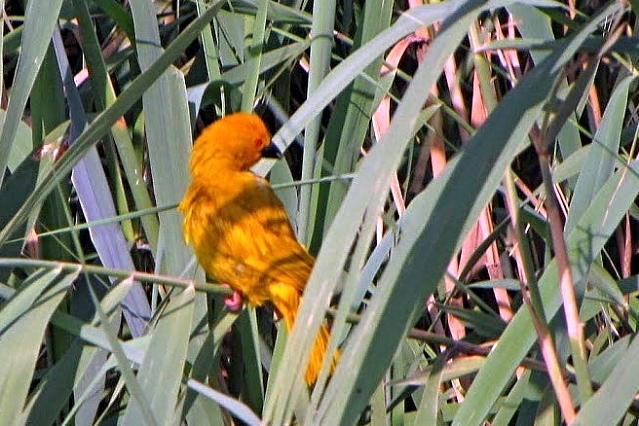 © Lisbeth
© Lisbeth
Male
 © Lisbeth
© Lisbeth
Male
 © Peter Connan
© Peter Connan
 © Peter Connan
© Peter Connan
Male, Maphelane, iSimangaliso Wetland Park, KwaZulu-Natal
Links:
Species text Sabap1
Sabap2
Weaver Wednesday: Eastern Golden Weaver
Ian Sinclair. SASOL VOELS VAN SUIDER AFRICA (3de UIT)
Iris colours in ageing and sexing South African Ploceus weavers. Afring News 40:7-12
 © Toko
© Toko Male
 © Lisbeth
© LisbethMale
 © Lisbeth
© LisbethMale
 © Peter Connan
© Peter Connan © Peter Connan
© Peter ConnanMale, Maphelane, iSimangaliso Wetland Park, KwaZulu-Natal
Links:
Species text Sabap1
Sabap2
Weaver Wednesday: Eastern Golden Weaver
Ian Sinclair. SASOL VOELS VAN SUIDER AFRICA (3de UIT)
Iris colours in ageing and sexing South African Ploceus weavers. Afring News 40:7-12
Holub's Golden Weaver
816. Holub's Golden Weaver, Golden Weaver Ploceus xanthops (Goudwewer)
Order: Passeriformes. Family: Ploceidae
Description
Length 17-18 cm. Yellow to light orange eye and heavy bill diagnostic in both sexes (eye red in Eastern Golden Weaver). The sexes are similar but males have an orange wash on the throat and upper breast. Bill black (breeding) or pinkish horn (non-breeding). Legs and feet pinkish brown.
Breeding male: Combination of large black bill, pale yellow eyes and lack of black facial markings diagnostic. Above plain olive green; below golden yellow, washed pale chestnut brown on throat and breast. Forecrown and face golden yellow, shading to chrome yellow on underparts, centre of throat and upper breast washed orange (Eastern Golden Weaver lemon yellow without orange wash); rest of upperparts golden green without streaking (faintly streaked in Eastern Golden Weaver).
Female and non-breeding male: Similar to male, but less bright. Above yellowish green, including forehead (back not streaked as in female Yellow Weaver); below lemon yellow.
Juvenile: Similar to adult female.
Similar species: The Holub's Golden Weaver is larger and heavier-billed than the Eastern Golden Weaver, and the eye is pale yellow, not red. Juveniles have longer tails than other similar juvenile weavers.
Distribution
It occurs from Congo and Uganda through southern DRC, Zambia and Angola to southern Africa. Here it is common from central Mozambique to Zimbabwe, northern Botswana, the far north of Namibia (including the Caprivi Strip) and eastern South Africa.
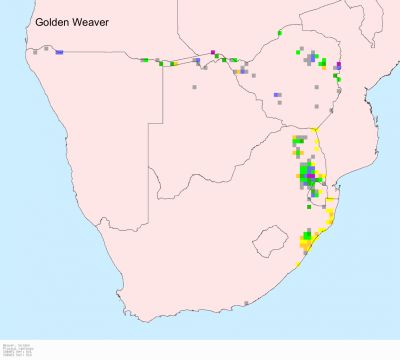
Habitat
It generally prefers grassy thicket along forest edges, well-wooded savanna, riparian woodland and rank waterside vegetation with trees.
Diet
A variety of fruit, insects, seeds and nectar, doing most of its foraging in dense vegetation. Holub's Golden Weavers feed on a variety of food including insects, berries, fruits, green and ripe seeds of grasses, seeds and nectar. They extract grubs from pods; termite alates are caught on the ground or on the wing. Young are fed on spiders and insects like grasshoppers, praying mantises, and tabanid flies.
Breeding
The Holub's Golden Weaver is a territorial, monogamous, semi-colonial nester. Two or three territorial males often breed in a loose colony of 2-5 nests each. The male builds 1-5 nests, but usually only one is used for eggs. The breeding season is Jan-Apr over much of its range. The nest is an untidy, bulky kidney-shaped structure made of woven coarse grass, which is lined by the female with grass inflorescences and plant down. It is typically attached to a drooping branch or suspended between to reeds or grass stems. Egg-laying season is from August to April, peaking from October to February. Eggs are plain blue, white or pinkish, or evenly freckled with red and lilac. The female lays 1-3 eggs, which are incubated solely by the female for about 14-15 days. The chicks are fed by both parents but mainly the female, leaving the nest after about 19-21 days.
Call
A typical weaver-like chuck and sustained swizzling calls as in other weavers.
Status
Uncommon resident.
Order: Passeriformes. Family: Ploceidae
Description
Length 17-18 cm. Yellow to light orange eye and heavy bill diagnostic in both sexes (eye red in Eastern Golden Weaver). The sexes are similar but males have an orange wash on the throat and upper breast. Bill black (breeding) or pinkish horn (non-breeding). Legs and feet pinkish brown.
Breeding male: Combination of large black bill, pale yellow eyes and lack of black facial markings diagnostic. Above plain olive green; below golden yellow, washed pale chestnut brown on throat and breast. Forecrown and face golden yellow, shading to chrome yellow on underparts, centre of throat and upper breast washed orange (Eastern Golden Weaver lemon yellow without orange wash); rest of upperparts golden green without streaking (faintly streaked in Eastern Golden Weaver).
Female and non-breeding male: Similar to male, but less bright. Above yellowish green, including forehead (back not streaked as in female Yellow Weaver); below lemon yellow.
Juvenile: Similar to adult female.
Similar species: The Holub's Golden Weaver is larger and heavier-billed than the Eastern Golden Weaver, and the eye is pale yellow, not red. Juveniles have longer tails than other similar juvenile weavers.
Distribution
It occurs from Congo and Uganda through southern DRC, Zambia and Angola to southern Africa. Here it is common from central Mozambique to Zimbabwe, northern Botswana, the far north of Namibia (including the Caprivi Strip) and eastern South Africa.

Habitat
It generally prefers grassy thicket along forest edges, well-wooded savanna, riparian woodland and rank waterside vegetation with trees.
Diet
A variety of fruit, insects, seeds and nectar, doing most of its foraging in dense vegetation. Holub's Golden Weavers feed on a variety of food including insects, berries, fruits, green and ripe seeds of grasses, seeds and nectar. They extract grubs from pods; termite alates are caught on the ground or on the wing. Young are fed on spiders and insects like grasshoppers, praying mantises, and tabanid flies.
Breeding
The Holub's Golden Weaver is a territorial, monogamous, semi-colonial nester. Two or three territorial males often breed in a loose colony of 2-5 nests each. The male builds 1-5 nests, but usually only one is used for eggs. The breeding season is Jan-Apr over much of its range. The nest is an untidy, bulky kidney-shaped structure made of woven coarse grass, which is lined by the female with grass inflorescences and plant down. It is typically attached to a drooping branch or suspended between to reeds or grass stems. Egg-laying season is from August to April, peaking from October to February. Eggs are plain blue, white or pinkish, or evenly freckled with red and lilac. The female lays 1-3 eggs, which are incubated solely by the female for about 14-15 days. The chicks are fed by both parents but mainly the female, leaving the nest after about 19-21 days.
Call
A typical weaver-like chuck and sustained swizzling calls as in other weavers.
Status
Uncommon resident.
Holub's Golden Weaver Photos
816. Holub's Golden Weaver Ploceus xanthops
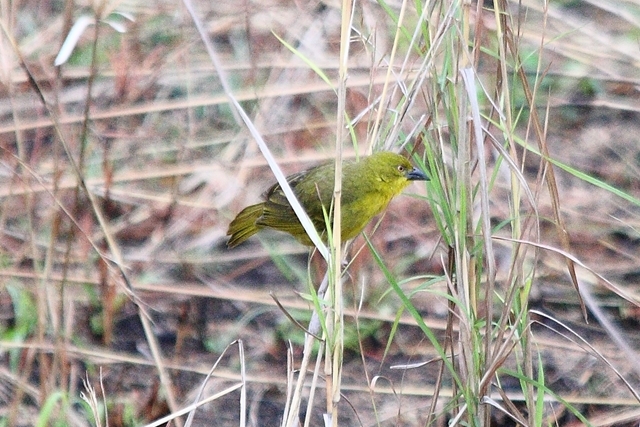 © Flutterby
© Flutterby
Female, Kruger National Park, near Phabeni
Links:
Species text Sabap1: http://sabap2.adu.org.za/docs/sabap1/816.pdf
Sabap2: http://sabap2.adu.org.za/species_info.p ... #menu_left
Ian Sinclair. SASOL VOELS VAN SUIDER AFRICA (3de UIT)
Weaver Watch: http://weavers.adu.org.za/sp.php?spp=801
 © Flutterby
© FlutterbyFemale, Kruger National Park, near Phabeni
Links:
Species text Sabap1: http://sabap2.adu.org.za/docs/sabap1/816.pdf
Sabap2: http://sabap2.adu.org.za/species_info.p ... #menu_left
Ian Sinclair. SASOL VOELS VAN SUIDER AFRICA (3de UIT)
Weaver Watch: http://weavers.adu.org.za/sp.php?spp=801
- Amoli
- Posts: 6032
- Joined: Fri Jun 01, 2012 4:30 am
- Country: South Africa
- Location: Kempton Park
- Contact:
Southern Brown-throated Weaver
818. Southern Brown-throated Weaver Ploceus xanthopterus (Bruinkeelwewer)
Order: Passeriformes. Family: Ploceidae
Description
Length 15 cm. The Southern Brown-throated Weaver is a small weaver, with a short tail.
The breeding male is the only weaver in its range with a brown face and throat which are demarcated from the yellow head. Bright yellow, washed green on back, with a chestnut face, and throat; chestnut does not extend onto the forecrown. The eyes are dull reddish brown.
Females, non-breeding males and young birds have a distinct cinnamon wash on the upperparts, below light yellow, shading to white in centre of belly and the bill is two-toned.
Similar species: Distinguished from Cape Weaver by being a more brilliant yellow colouration, by lacking the orange wash over the face and crown, and by having a brown, not pale eye.
Distribution
Occurs from southern Tanzania and north-eastern Mozambique through Zambia and Angola to southern Africa. Here it is uncommon and localised in three separate areas: northern Botswana and the Caprivi Strip (Namibia), north-eastern Zimbabwe and central Mozambique and from southern Mozambique to KwaZulu-Natal.
Taxonomy
There are three subspecies of the Southern Brown-throated Weaver, with disjunct distributions:
P. x. xanthopterus, found in Tanzania, Malawi, Mozambique south to the Zambezi River, and NE Zimbabwe.
P. x. castaneigula, in the Caprivi in Namibia, the Okavango in Botswana and the upper Zambezi River. This subspecies is larger than the nominate race, and the male has the crown orange-yellow, in contrast to the green mantle.
P. x. marleyi, in Mozambique from the Save River, southwards, SE Zimbabwe, South Africa. In this subspecies the male has the crown bright yellow, with little contrast with the mantle; and the throat is tawny rather than chestnut.
Habitat
It generally prefers reedbeds and Papyrus (Cyperus papyrus) swamps while breeding, but in the non-breeding season it may also move into woodland, thickets, grassland and forest.
Diet
It mainly eats insects, seeds, berries and flowers, doing most of its foraging in vegetation, gleaning food from leaves and branches.
Breeding
Polygamous, as males mate with multiple females per breeding season, either nesting singly or in colonies of 10-300 nests. The male may build up to about 12 nests in a breeding season, which consist of an untidy oval with an entrance hole on the bottom, woven from thin strips of reeds or grass and lined by the female with grass seedheads and reed flowers. It is typically attached to 1-3 reed stems at least one metre above water, rarely using a tree instead. Egg-laying season is from about October-January. It lays 2-3 eggs, which are incubated solely by the female for about 14-17 days. The chicks are fed by the female only, leaving the nest after about 14-19 days.
Call
A soft zweek, zweek. Listen to Bird Call.
Status
Uncommon localised resident. Not threatened, although it is very vulnerable to the destruction of wetlands.
Order: Passeriformes. Family: Ploceidae
Description
Length 15 cm. The Southern Brown-throated Weaver is a small weaver, with a short tail.
The breeding male is the only weaver in its range with a brown face and throat which are demarcated from the yellow head. Bright yellow, washed green on back, with a chestnut face, and throat; chestnut does not extend onto the forecrown. The eyes are dull reddish brown.
Females, non-breeding males and young birds have a distinct cinnamon wash on the upperparts, below light yellow, shading to white in centre of belly and the bill is two-toned.
Similar species: Distinguished from Cape Weaver by being a more brilliant yellow colouration, by lacking the orange wash over the face and crown, and by having a brown, not pale eye.
Distribution
Occurs from southern Tanzania and north-eastern Mozambique through Zambia and Angola to southern Africa. Here it is uncommon and localised in three separate areas: northern Botswana and the Caprivi Strip (Namibia), north-eastern Zimbabwe and central Mozambique and from southern Mozambique to KwaZulu-Natal.
Taxonomy
There are three subspecies of the Southern Brown-throated Weaver, with disjunct distributions:
P. x. xanthopterus, found in Tanzania, Malawi, Mozambique south to the Zambezi River, and NE Zimbabwe.
P. x. castaneigula, in the Caprivi in Namibia, the Okavango in Botswana and the upper Zambezi River. This subspecies is larger than the nominate race, and the male has the crown orange-yellow, in contrast to the green mantle.
P. x. marleyi, in Mozambique from the Save River, southwards, SE Zimbabwe, South Africa. In this subspecies the male has the crown bright yellow, with little contrast with the mantle; and the throat is tawny rather than chestnut.
Habitat
It generally prefers reedbeds and Papyrus (Cyperus papyrus) swamps while breeding, but in the non-breeding season it may also move into woodland, thickets, grassland and forest.
Diet
It mainly eats insects, seeds, berries and flowers, doing most of its foraging in vegetation, gleaning food from leaves and branches.
Breeding
Polygamous, as males mate with multiple females per breeding season, either nesting singly or in colonies of 10-300 nests. The male may build up to about 12 nests in a breeding season, which consist of an untidy oval with an entrance hole on the bottom, woven from thin strips of reeds or grass and lined by the female with grass seedheads and reed flowers. It is typically attached to 1-3 reed stems at least one metre above water, rarely using a tree instead. Egg-laying season is from about October-January. It lays 2-3 eggs, which are incubated solely by the female for about 14-17 days. The chicks are fed by the female only, leaving the nest after about 14-19 days.
Call
A soft zweek, zweek. Listen to Bird Call.
Status
Uncommon localised resident. Not threatened, although it is very vulnerable to the destruction of wetlands.
Pretoriuskop
Satara
Shingwedzi
20-30 Dec 2014
Satara
Shingwedzi
20-30 Dec 2014
- Amoli
- Posts: 6032
- Joined: Fri Jun 01, 2012 4:30 am
- Country: South Africa
- Location: Kempton Park
- Contact:
Southern Brown-throated Weaver Photos
818. Southern Brown-throated Weaver Ploceus xanthopterus (Bruinkeelwewer)

Kruger National Park
Links:
Species text in The Atlas of Southern African Birds: http://sabap2.adu.org.za/docs/sabap1/818.pdf
Sabap2: http://sabap2.adu.org.za/spp_summary.ph ... §ion=3]
Ian Sinclair. SASOL VOELS VAN SUIDER AFRICA (3de UIT)
Weaver Wednesday: Southern Brown-throated Weaver
Iris colours in ageing and sexing South African Ploceus weavers. Afring News 40:7-12

Kruger National Park
Links:
Species text in The Atlas of Southern African Birds: http://sabap2.adu.org.za/docs/sabap1/818.pdf
Sabap2: http://sabap2.adu.org.za/spp_summary.ph ... §ion=3]
Ian Sinclair. SASOL VOELS VAN SUIDER AFRICA (3de UIT)
Weaver Wednesday: Southern Brown-throated Weaver
Iris colours in ageing and sexing South African Ploceus weavers. Afring News 40:7-12
Pretoriuskop
Satara
Shingwedzi
20-30 Dec 2014
Satara
Shingwedzi
20-30 Dec 2014


